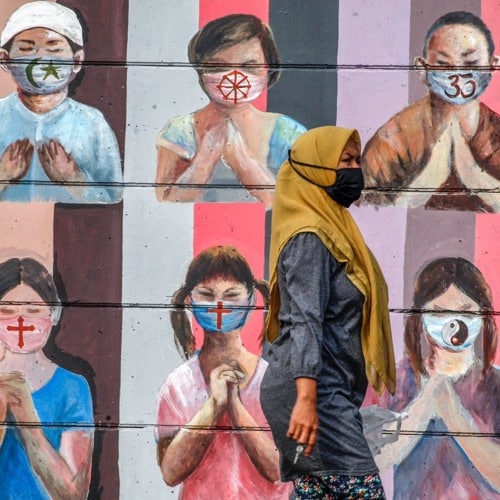Indonesia, the world’s largest archipelago, is a mosaic of cultures and beliefs, where myriad religions coexist. At the heart of this vibrant tapestry lies the question: how do Islam, Hinduism, and Christianity interact within this diverse society? This inquiry not only invites exploration into the intricate dynamics of faith in Indonesia but also challenges us to consider the implications of religious harmony in a predominantly Muslim nation.
The dominant religion in Indonesia is Islam, with over 87% of the population identifying as Muslim. This commitment to the faith shapes not only personal lives but also public policies and cultural practices. Islamic teachings permeate daily routines—from prayer five times a day to the observance of Ramadan, the holy month of fasting. In a nation formed on the principle of Pancasila, which promotes the idea of religious tolerance and mutual respect, one can observe a vast spectrum of Islamic expressions, from the conservative to the more liberal interpretations. Yet, while Islam prevails, an undercurrent of pluralism exists, allowing other religions to flourish alongside.
Hinduism represents the second-largest religion in Indonesia, albeit a minority one. Primarily found on the island of Bali, Hinduism informs the cultural fabric through colorful rituals, temple festivities, and a profound reverence for the arts. The Balinese practice a unique variant of Hinduism, imbued with local traditions and customs that differ significantly from the Indian subcontinent’s Hindu practices. The visible presence of temples, ceremonial processions, and sacred dances drape Bali in spiritual vibrancy. This denotes not only the persistence of Hinduism but also demonstrates its harmonious integration within a predominantly Islamic context, revealing a profound coexistence that confounds simplistic dichotomies of conflict between faiths.
In the Christian perspective, this coexistence raises intriguing questions. How can a faith traditionally rooted in the tenets of exclusivity and truth claims navigate a landscape where pluralism is not only tolerated but celebrated? The Christian presence in Indonesia commands attention, not only as a minority of around 10% but as a vibrant community making palpable impacts in various societal spheres. From education to healthcare, Christians contribute to the nation’s wellbeing, often acting as mediators in interfaith dialogues. However, these interactions are not devoid of challenges. Christians may find themselves grappling with the delicate balance of proclaiming their faith while also respecting the predominant Islamic identity of the country.
This juxtaposition evokes a multifaceted discourse on religious harmony, examining the philosophical underpinnings that govern interfaith relationships. Within Christian teachings, the concept of love for one’s neighbor transcends religious boundaries, proposing a radical stance of engagement rather than withdrawal. The New Testament emphasizes the imperative of loving others unconditionally, fostering environments for dialogue and cooperation. In Indonesia, such an ethos resonates with the broader principles enshrined in Pancasila. The challenge lies in the execution of these ideals in a real world often rife with suspicion and misunderstanding. How can Christians cultivate spaces for understanding without compromising their own convictions?
The Indonesian context offers both aspirations and caveats. The nation is often heralded as a model for religious tolerance, yet underlying tensions occasionally bubble to the surface, evidenced by sporadic attacks on Christian communities or political rhetoric that marginalizes religious minorities. Analyzing these incidents reveals that genuine harmony is not merely an absence of conflict, but the presence of active engagement and mutual understanding. Hence, the challenge posed to Christians—and to all adherents of faith—is to develop relationships steeped in empathy, setting aside prejudices that often obscure the essence of existence within a pluralistic society.
Furthermore, one cannot overlook the role of youth in shaping the future of interfaith relations. Indonesia’s young population, brimming with potential and equipped with modern tools for communication, is pivotal in forging a path towards genuine dialogue. Initiatives involving youth interfaith dialogues have emerged, illustrating collective efforts in bridging gaps. Yet, an essential question remains: how can these burgeoning leaders be fortified with the knowledge and tools to navigate the complexities inherent in a diverse religious landscape while retaining their unique identities? The answer may lie in fostering education that emphasizes core commonalities as well as respect for differences.
Moreover, as global influences permeate Indonesian society, the interplay of globalization and local traditions presents both opportunities and challenges for religious harmony. The proliferation of information technology invites a new era of dialogue, enabling individuals from different faith backgrounds to engage in discussions that transcend geographic barriers. However, it also propels forward narratives that could threaten established norms. Herein lies another inquiry: can a balance be struck that allows for innovation while honoring the rich historical legacies of Indonesia’s diverse faiths? It is within these inquiries—interfaith actions laden with the spirit of inclusivity and respect—where the seeds of enduring peace may find fertile ground.
In conclusion, the panorama of Indonesia’s religious landscape is underscored by a complex interplay of coexistence and challenge. As Islam, Hinduism, and Christianity endeavor to navigate this intricate milieu, the principles of mutual respect and love emerge as guiding lights. Embracing these ideals not only paves the way for constructive dialogue but also nurtures hope for a harmonized society. Ultimately, the ongoing narrative of religious harmony in Indonesia asks each individual to step beyond themselves and engage with the divine in their neighbors, forging paths to collective understanding and peace that resonates throughout the archipelago.



